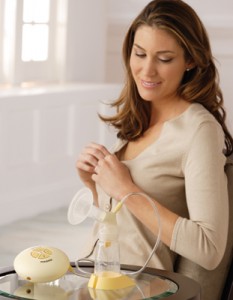 Breast pumps are used to suction milk from the breast into a container. But there are so many different types, how do I know which one is right for me? Dr. Sears explains that the differences among types of pumps include:
Breast pumps are used to suction milk from the breast into a container. But there are so many different types, how do I know which one is right for me? Dr. Sears explains that the differences among types of pumps include:
* the power source behind the suction
* how much suction the pump produces
* how the suction-and-release cycle is controlled
* how many suction-and-release cycles the pump is able to produce each minute.
Hand pumps: The mother provides the power and regulates the suction by mechanical means, squeezing a trigger, moving a cylinder, or even pumping with her foot.
Electric pumps: The suction is generated by a motor. With some electric pumps, the mother uncovers and covers a small hole with her finger to regulate the strength of the suction and the suction-and-release cycles. With most electric pumps, the suction-and-release cycle is controlled by the pump, and the better pumps allow the mother to adjust the suction level and the speed.
Generally speaking, pumps that allow for more cycles per minute are more effective. A cheaper electric pumps with a small motor may be able to generate only five suction-and-release cycles per minute. The slower cycling rate is harder on your nipples, since they are subjected to longer periods of unrelieved suction. The better quality electric pumps (the kind you rent or can purchase for a higher price), cycle up to 60 times per minute.
How good of a pump do I need?
Some women can pump milk easily and get several ounces at a session no matter what kind of pump they use, but most women get more milk if they use a higher quality pump. What kind of pump to buy depends on why you are pumping milk:
* If you are pumping milk only to leave an occasional bottle for your baby or to store milk in your freezer for a rainy day, you don’t need a top-of-the-line pump.
* If you are using a pump to establish or maintain your milk supply for a baby who can not nurse at the breast or who has not yet learned how to nurse efficiently, you should rent a higher quality pump. Using a lower quality pump is not worth the effort involved or the risk to your milk supply.
* If you are a working mother, or pumping while on the job, the type of pump you use will depend on how long you are separated from your baby each day, where you will be pumping, how old your baby is, and other convenience factors. Don’t try to skimp and make do with a less effective pump. The easier and more convenient it is to pump the better you will feel about taking on the challenges of breastfeeding and working.
The more you are depending on your pump, the more important it is to use a high- quality pump. As you consider different pumps, take these factors into account:
* What is your reason for pumping? If you are trying to establish and maintain a milk supply for a baby who can’t yet nurse, you’ll need a better quality pump than if you are pumping occasionally to keep milk in the freezer for an emergency.
* How old is your baby? Will you be pumping for many, many months? (This may influence whether you rent or buy.)
* Will you be having another baby, so that you’ll use the pump again?
* Do you need the convenience and speed of double-pumping (pumping both breasts at the same time)?
* If your alternative to pumping is formula-feeding, compare the prices. Even the more expensive pumps may come out looking economical by this standard.
* Battery-operated pumps go through batteries quickly. Pumps that come with an adapter for electrical outlets can give you the flexibility you need without having to depend on batteries for power. Where will you be pumping the most: at home, in your car, at your desk, in the ladies’ room? (Some restrooms don’t have electric outlets.)
* Do you need a pump that’s lightweight and portable? Will you be carrying your pump back and forth to work every day, or will it stay in one place?
* Expect to take as much time to pump as the average time it takes to breastfeed your baby (which is usually around thirty minutes). A double-pumping system cuts the time in half and may yield more milk and higher prolactin levels in the blood. It might seem that double- pumping would require two hands, but enterprising mothers find a way to hold both breast flanges with one forearm, sometimes with the help of a desk or table. This leaves one hand free for answering the phone, turning pages, or eating your lunch. (The Medela company even sells a kit for hooking a pump up to your bra for hands-free pumping.) We know of one mother, a sales rep, who pumps one breast at a time while driving between appointments.
Where to purchase breast pumps
You can buy a pumps at the local discount or drug store, but these are often not the best choice. Companies that specialize in manufacturing breast pumps make their products available through lactation consultants, La Leche League International and other businesses that sell breastfeeding products. You can also buy pumps online or through catalogs. However, if you’re the sort of person who likes to be shown how things work, you might prefer to purchase your pump from a lactation consultant or La Leche League Leader who can show you how to put it together and answer questions you may have.
Pump companies state that breast pumps are one-user items, except for the rental pumps, and for those you must purchase your own accessory kit. It may not be a good idea to purchase a used pump–whether from a garage sale or an online auction.
Dr. Sear’s Breast Pump Guide has a detailed listing of types of pumps, brand names, and the advantages and disadvantages of each.
Image shows the award winning Medela Swing Breast Pump.





has the electric milk pump achieved CE approval? could you send a copy of certificate to me?